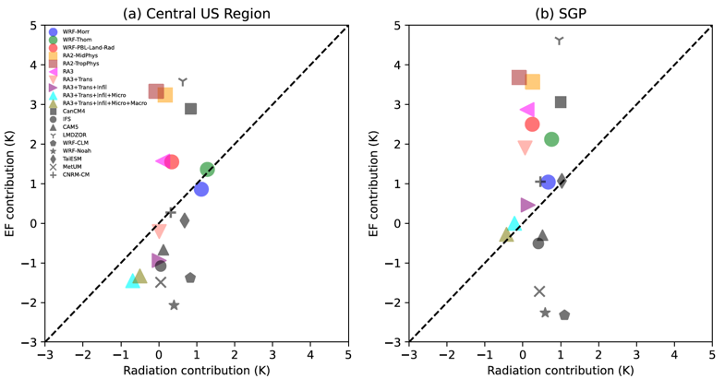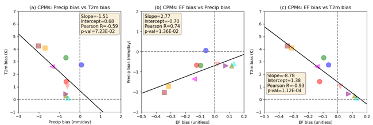Summertime near-surface temperature biases over the central U.S. in convection-permitting simulations
Submitter
Zhang, Yunyan — Lawrence Livermore National Laboratory
Area of research
Cloud Processes
Journal Reference
Science
Near-surface air temperature (T2m) is one of the most important meteorological variables in weather forecasting and climate projections. However, the simulation of T2m suffers from systematic warm biases during summertime over the central U.S. in many weather and climate prediction models. These long-standing T2m biases hinder our ability to credibly project future climate. One of the main hypotheses is that the inability of Earth system models to simulate mesoscale convective systems (MCSs) that provide 30-70% of total warm-season precipitation over the central U.S. is the first-order culprit for the rainfall dry bias and hence the T2m warm bias. Higher-resolution models have been developed that explicitly resolve deep convection and have been integrated in simulations approaching climate timescales, typically referred to as convection-permitting models (CPMs). CPMs can improve the simulations of MCSs and other precipitation. In light of these new ultra-high-resolution simulations, scientists at Lawrence Livermore National Laboratory, in collaboration with scientists from Pacific Northwest National Laboratory, and the UK Met Office, studied to understand the causes of warm biases in T2m and related underestimates of precipitation, including that from MCSs with CPM simulations.
Impact
This study demonstrates that land processes and land-atmosphere interactions play a very important role in determining the summertime climate of the central U.S. This should be the main future focus on improving the two-way interactions between atmospheric convection and surface climate in high-resolution models.
Summary
Based on 10 CPM simulations and 9 coarser-resolution model simulations, we quantify contributions from evaporative fraction (EF) and radiation to the T2m bias, with both types of models overestimating T2m largely because they underestimate EF. The performance of CPMs in capturing MCS characteristics (frequency, rainfall, propagation) varies. The pre-summer precipitation bias has large correlation with mean summertime T2m bias but the relationship between summertime MCS mean rainfall bias and T2m bias is non-monotonic. Analysis of lifting condensation level deficit and convective available potential energy suggests that models with T2m warm biases and low EF have too dry and stable boundary layers, inhibiting the formation of clouds, precipitation, and MCSs. Among the CPMs with differing model formulations (e.g., transpiration, infiltration, cloud macrophysics, and microphysics), evidence suggests that altering the land-surface model is more effective than altering the atmospheric model in reducing T2m biases.



